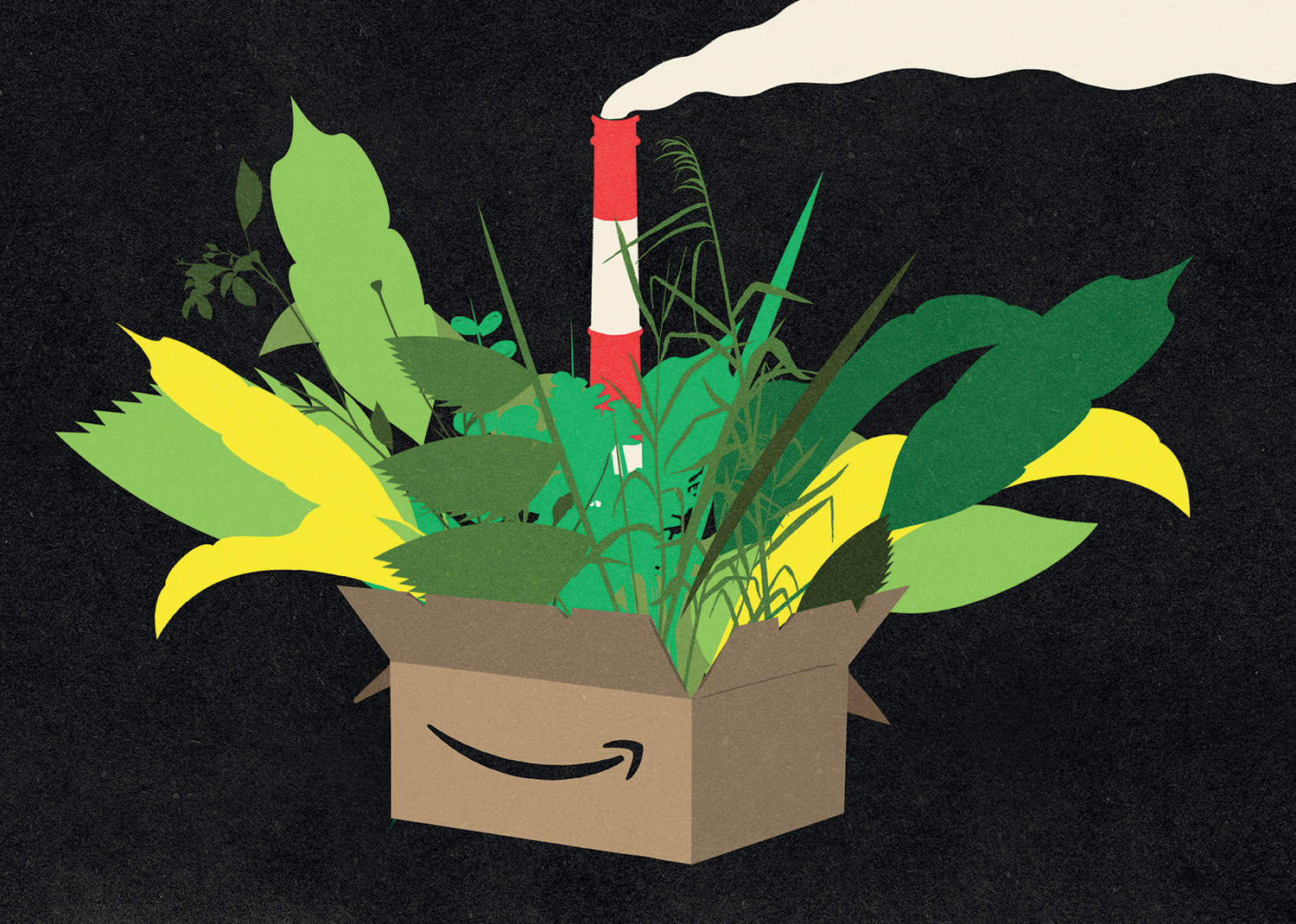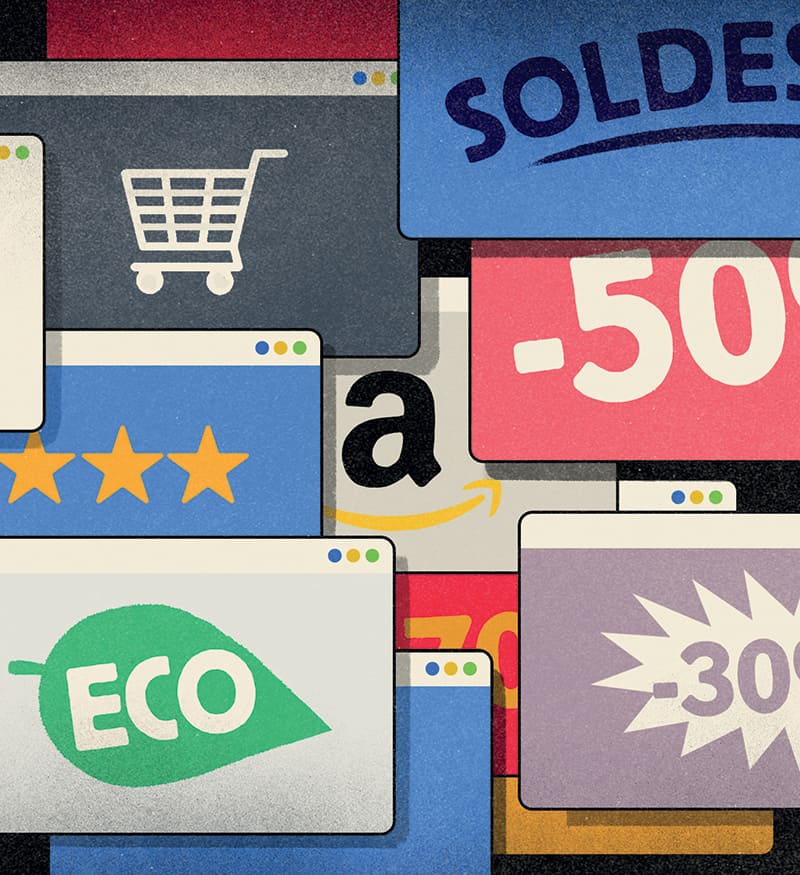10 Stereotypes about Amazon

1. On social and environmental issues, Amazon’s track record is abysmal.
Benoît Berthelot, journalist for the monthly Capital, specialist in new technologies, author (after a three-year study) of the book “Le Monde selon Amazon” (“The World according to Amazon”), published by Le Cherche Midi.
TRUE – Amazon emits 44 million tons of CO2 equivalent per year. Among global leaders in the cloud-computing and e-commerce sectors, Amazon is one of the biggest polluters: its international and local logistics network involves non-stop trips by small trucks, 18-wheelers, cargo planes…. Its subsidiary Amazon Air, for example, operates a fleet of more than 80 aircraft. From pollution to tax avoidance, along with crushing the competition, Jeff Bezos has built his empire without any concern for negative externalities. To deliver to its clients as quickly as possible, the company’s flow of goods is poorly optimized compared to conventional trading systems: Amazon sends its trucks out from its warehouses every two hours, whether they are full or only a quarter full. Only when forced by its activist employees, many of whom lost their jobs, did Amazon publish its carbon footprint and commit to long-term goals (carbon neutrality by 2040 and reliance on 80% renewable energy by 2024). But in practice, all its activities tend to intensify its pollution. The company seems to be at an impasse. Employing 800,000 people worldwide, Amazon also has a questionable social record. In its warehouses, demanding and repetitive jobs by materials handlers are even computer-monitored to ensure optimal efficiency.
2. Amazon is a slave-driver that flouts labor regulations and the dignity of the employees who work in its warehouses.
Charles-Henri Besseyre des Horts, emeritus professor of management and human resources at HEC Paris.

NOT SO SIMPLE – It’s true that anyone who goes to work for Amazon must be aware that working conditions will be quite constrained. The company’s incredible logistics-services model demands exceptional productivity of its workers and grants them limited autonomy. Everything is set up so that the time between a customer making an order and the delivery of that order should be the shortest possible, so employees are under pressure. The e-commerce giant is regularly criticized for the working conditions imposed on employees in its warehouses. Former employees describe the intense pace of their jobs and their inhuman treatment. In fact, the multinational implements the Taylor model in its original sense, in other words it makes a marked distinction between conception and execution. This approach becomes a problem, however, when the company owner fails to follow Taylor’s recommendation to share added value fairly with workers, and Amazon’s CEO is often criticized for paying his employees too little. Two years ago, former presidential candidate Bernie Sanders proposed a “Stop Bezos” law to force Jeff Bezos to pay his employees more.
3. Amazon is the tax-fraud champion.
Mirko Hayat, adjunct professor in HEC’s Tax and Law department and co-author of “La Fin des paradis fiscaux?” (“The End of Tax Havens? ”) published by LGD.
NOT SO SIMPLE – Like all companies in the new economy, Amazon takes advantage of loopholes in an outdated international tax system that is incapable of dealing with the 21st century’s new forms of value creation. This is understandable, since the system was conceived between the two world wars and has evolved very little since then. In a nutshell, the current system is ill-adapted because it is basically founded on the notion that companies have a physical presence. Yet the Internet economy is mainly intangible. Even when, in the case of Amazon, physical goods are delivered, the company generally does not own them. GAFAMs don’t have to have a physical presence in the countries where they sell products. This is why the OECD has been trying for many years to come up with a more effective system in which, in defining economic substance, we consider market presence rather than physical presence. In this approach, part of the profits these companies earn would be paid to the countries in which they sell products, even if the companies do not have a physical presence there; countries would be responsible for levying such taxes. If such a system – which I believe is justified – is to be effective, it has to be implemented in a lot of countries. We’re moving in the right direction, and the conclusion of an agreement is on the way. As an example, the first provision in this reform measure would specify redistributing 100 billion dollars in profits to different countries, which would be to the detriment of tax havens and countries amenable to tax dumping (the Netherlands, Ireland, Singapore…).
4. Amazon has killed off bookstores.
Fleur d’Harcourt (H.12), Editorial director at Autrement, Madrigall group.

FALSE – Bookstores are certainly not dead – and they’re probably doing better in October 2020 than they were in October 2019 [note: the interview was conducted on October 12, 2020]. For certain French people, lockdowns have meant extra time for reading (since many outdoor leisure activities have been curtailed), and many have chosen – out of principle – to avoid buying from Amazon. This is in line with a general trend toward responsible and local shopping. During the lockdown, people rediscovered their neighborhood bookstores thanks to online ordering with in-store pickup, and after the lockdown they rediscovered the pleasure of the human contact and personal recommendations they can count on in bookstores, as well as feeling good about shopping ethically and supporting book-industry players who have been hurt by the crisis. Another advantage of bookstores is that (except during lockdowns and curfews) they organize conferences and appearances by authors, something that Amazon is not at all interested in doing. A bookstore can certainly organize videoconferences with authors, for example. But let’s be clear: Amazon is a special kind of competitor, because it offers many kinds of services, for example the ability to acquire hard-to-find books or, when it comes to obtaining required textbooks, parents can just order with a click instead of having to go to a store. And even though Amazon doesn’t share information about the geographical locations of its book orders, its services are mainly used by residents of rural areas rather than people in cities.
5. Amazon hurts local economies by cornering the market.
Jean Monnier (H.88), former head of Auchan Direct, CEO of the luxury e-commerce enterprise 24S.
BASICALLY TRUE – Amazon is in the crosshairs of many anti-trust lobbies thanks to its negative impact on local trade. This impact is undeniable, particularly during the covid pandemic. Although it’s difficult to estimate exactly what part Amazon has played in closing down local stores, we know that Amazon achieves a lot of its turnover through a shift from one distribution channel to another. Nevertheless, many local stores have resisted this trend by reinventing themselves, for example by focusing on home deliveries, curbside pickup, or their capacity to offer personal services. A small part of Amazon’s activity actually boosts local economies through deliveries to pick up points. We must remember, though, that, even before Amazon, neighborhood stores were under threat from major retail chains. In addition, if we consider the expression “local economy” in general, we have to keep in mind that Amazon has set up warehouses all over France where it employs legions of workers, though certainly ones with limited qualifications. In fact, an e-commerce seller probably employs more people to get a particular product to a customer than a major retail chain does. Paradoxically, the digital revolution, particularly online sales of physical products, tends to create jobs.
6. Amazon will soon be number one in physical distribution.
Jean-Daniel Pick (H.81), president of the HEC Commerce et Distribution (Trading and Retail) club, founder of the Strategy division at EY-Parthenon, coach and investor in the HEC incubator
FALSE – Even though Amazon has increased its physical presence recently, by acquiring the organic-foods group Whole Foods in 2017 and launching its automated local shops in 2018, it’s not likely that it will massively expand this kind of presence over the next few years, for the simple reason that this model is less profitable than Internet services or logistics infrastructure. Costs of commercial real estate, staff and daily resupplying are more capital-intensive than operating centralized warehouses. As for fully automated local shops, labeled Amazon Go, their establishment is only justified in areas where labor costs are really high. This is the case in France, for example, but it’s too late for Amazon to join the local-shopping battle, which has been going on for 10 years with chains like Casino, Carrefour, Auchan and Intermarché. More importantly, stores are focusing more and more on their mission to be a place where customers can discover new things, have experiences, and benefit from assistance. It’s not enough to just have products on shelves, not to mention the constraint that fresh foods and local-specialty products require short supply chains. For Amazon, the best way to be involved in local markets is through deliveries. I think the company’s recent efforts to have a physical presence are just an experiment.
7. No one can compete with Amazon.
Adrien Nussenbaum (H.01), founder of the startup Mirakl, provider of marketplace solutions

FALSE – Amazon is ready to do anything to beat its competitors. We’ve seen it: to compete with big retail chains, Amazon sets its own prices even lower than the chains’ prices to cause problems for them, and then acquires these businesses for as little as possible. In line with this tactic of putting competition over profits, Amazon will even buy the best-selling products of its partner vendors and then sell them directly, offering the competitive edge of stepped-up delivery services. This is how Amazon has achieved an e-commerce monopoly. History teaches us, however, that every monopoly will end eventually or at least be challenged. In fact, the American giant already has some well-known competitors: Alibaba, Mercado Libre and Jumia, to name just a few. So yes, it’s possible to compete with Amazon, by fighting fire with fire: using Amazon’s business model, the marketplace, against it. Some of our clients are now achieving 3 billion euros in revenues because they were able to make the most of their advantages compared to Amazon: a brand image of high quality that inspires loyalty, a strong local presence, and a David-against-Goliath status, which is appealing to sellers looking for new kinds of distribution channels. As for Amazon’s customers, while they are generally happy with the supplier’s quality, prices and delivery services, some are put off by Amazon’s negative image, from the poor working conditions of its employees to its high carbon emissions and aggressive efforts to monopolize the market. Amazon’s competitors can make the most of this by proposing marketplaces for ethical and responsible products.
8. Amazon is very innovative in its procedures and technologies.
Marc Bordier (H.99), president of Lireka and a former Amazon employee from 2008 to 2018.
TRUE – At Amazon, every innovation is geared to the customer. This approach is much more innovative than one aimed at beating the competition, which is why Amazon describes itself as “customer-obsessed” instead of “competitor-obsessed”. Often, when Amazon has clearly understood and qualified a problem or client need, it will come up with its vision of a solution and will describe this in a fictitious “press release” accompanied by several pages of factsheets. This original document will be the object of many revisions and internal discussions, until the proposed innovation is very clear and everyone agrees with it. If it is approved, it will be applied throughout the Amazon network. This is how Amazon’s most successful innovations were born, like the Kindle, the supermarket Amazon Go, and Amazon Echo. During daily operations, innovation occurs thanks to mechanisms designed to pinpoint flaws or malfunctions and to automatically correct them. This approach can be applied to such diverse issues as discrepancies in bills, deliveries when clients are not at home, articles missing bar codes, or the replacement of defective merchandise. Finally, in its drive to be innovative, Amazon will take major risks, which was its case with the launch of the Fire Phone in 2014.* Among the 14 “leadership principles” on which Amazon’s corporate culture is based are “customer obsession” and “invent and simplify”.
9. Amazon is really not as interested in selling merchandise as in data, via its AWS cloud services.
Valentin Blanchot, editor-in-chief of Siècle Digital

BASICALLY TRUE – Amazon was one of the first to position itself in the cloud-computing sector, which includes such services as storage, management of databases, computing, live-stream encoding and audio transcoding. To deal with the huge amounts of data that handling its orders generated, the e-commerce giant developed its own data centers and eventually realized that these had applications beyond internal operations. AWS is now the global leader in public cloud computing, holding a 40% market share at the end of 2019, which equals the share held by its five main competitors combined (Microsoft, Google, Alibaba, Salesforce et IBM). Among Amazon’s clients are the digital behemoths Netflix, Apple and Facebook. Its cloud activities generate net profits equal to those of its e-commerce, from much less turnover. This is because its margins for cloud services are greater than for its online sales, since the latter requires a much greater investment in logistics and human resources. Amazon, then, has every reason to continue its cloud activities, especially in a world grown more and more connected. With the rapid growth of telecommuting and cloud gaming, there’s every indication that the cloud-computing sector will become more and more lucrative over time.
10. Amazon’s boss is a megalomanic who wants to send us into space when he’s finished destroying the planet.
Anne Monier, doctorate in social sciences, researcher with the ESSEC Business School Philanthropy Chair, author of “Nos Chers Amis américains” (“Our Beloved American Friends”; PUF 2019).
BASICALLY TRUE – If Jeff Bezos irritates his critics, it’s mostly because he always goes against the flow and stirs people up with his behavior. For example, his June 2017 tweet asking people for advice about his philanthropy generated tons of responses. People were amazed that he didn’t have a clear strategy on such an important issue, unlike Bill Gates, who focuses his philanthropy on healthcare, or Mark Zuckerberg, who focuses on education. Finding out whether he’s really crazy or a megalomanic would mean spending time with him. What’s certain is that he’s extremely ambitious and can seem egotistical, since it took him a long time to get involved in philanthropy at all. Up until 2018, he had donated “only” 100 million dollars to charity projects, while he had invested one billion dollars per year in his Blue Origin project, which aims to send people into space. As for his organization’s impact on the planet, it is currently very negative, mainly because of a massive reliance on fossil fuels. That is why Amazon’s big boss injected 10 billion dollars this year into the Bezos Earth Fund, which aims to fight climate change, and he announced in September this year that his multinational aims to reach carbon neutrality by 2040. This goal seems illusory. In fact, it appears that he got involved in philanthropy only when forced to do so by media pressure and comparisons with his counterparts, as well as by the need to improve Amazon’s image.
Interviews by Cyrielle Chazal and Marc Ouahnon
Published by La rédaction

